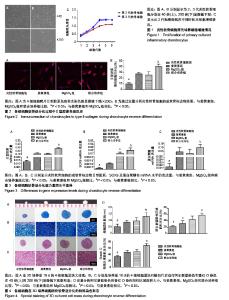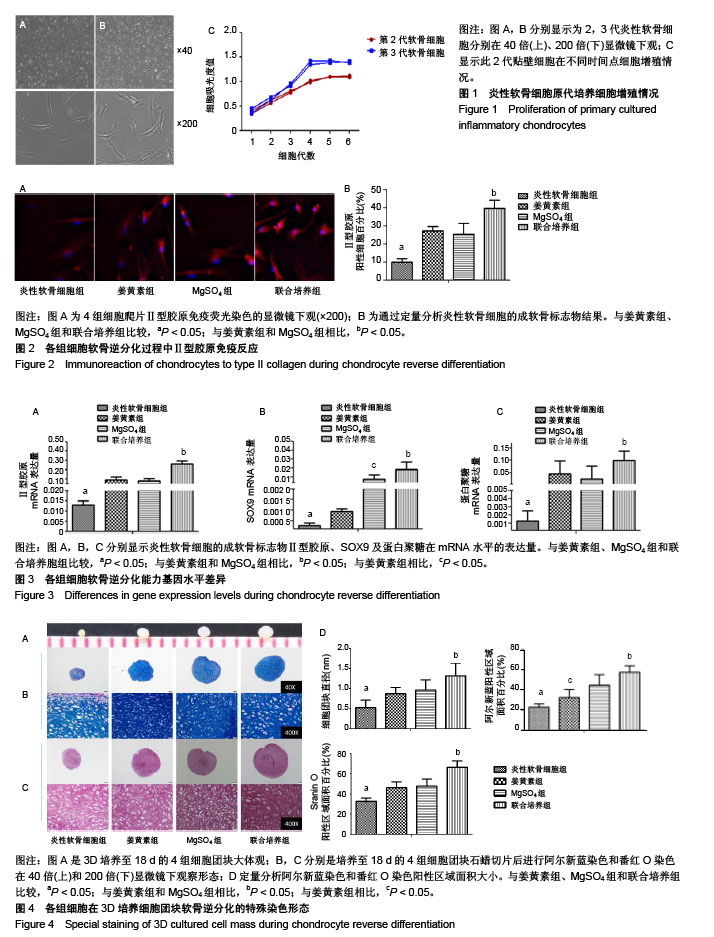| [1] Johnson VL, Hunter DJ. The epidemiology of osteoarthritis.Best Pract Res Clin Rheumatol. 2014;28(1):5-15. [2] Samuels J, Krasnokutsky S, Abramson SB. Osteoarthritis:a tale of three tissues. Bull NYU Hosp Jt Dis. 2008;66(3):244-250. [3] Takayama K, Ishida K, Matsushita T, et al. SIRT1 regulation of apoptosis of human chondrocytes. Arthritis Rheum. 2009;60(9):2731-2740. [4] 李云泽,赵序利.骨性关节炎发病机制研究进展[J].中国疼痛医学杂志,2016, 22(10):728-733.[5] 王亚非,丁建中.骨性关节炎治疗的研究进展[J].北京中医药,2010, 29(11):886-888.[6] Kalpravidh RW, Siritanaratkul N, Insain P, et al. Improvement in oxidative stress and antioxidant parameters in beta-thalassemia/Hb E patients treated with curcuminoids. Clin Biochem. 2010;43(4-5):424-429. [7] Khan MA, El-Khatib R, Rainsford KD, et al. Synthesis and anti-inflammatory properties of some aromatic and heterocyclic aromatic curcuminoids. Bioorg Chem. 2012;40(1):30-38. [8] Ye MX, Zhao YL, Li Y, et al. Curcumin reverses cis-platin resistance and promotes human lung adenocarcinoma A549/DDP cell apoptosis through HIF-1α and caspase-3 mechanisms. Phytomedicine. 2012; 19(8-9):779-87. [9] Campos CA, Gianino JB, Bailey BJ, et al. Design, synthesis, and evaluation of curcumin-derived arylheptanoids for glioblastoma and neuroblastoma cytotoxicity. Bioorg Med Chem Lett. 2013;23(24): 6874-6878. [10] Hong D, Zeng X, Xu W, et al. Altered profiles of gene expression in curcumin-treated rats with experimentally induced myocardial infarction. Pharmacol Res. 2010;61(2):142-148. [11] Phillips J, Moore-Medlin T, Sonavane K, et al. Curcumin inhibits UV radiation-induced skin cancer in SKH-1 mice. Otolaryngol Head Neck Surg. 2013;148(5):797-803. [12] 孙宗建,何琨,张东,等.姜黄素预先给药对兔呼吸机相关性肺损伤时Nrf2蛋白表达的影响[J].中华麻醉学杂志,2014,34(2):237-240.[13] 王健,王祥,马捷,岳冰,等.姜黄素对白细胞介素1β诱导兔骨关节炎标志物的作用[J].中华关节外科杂志(电子版),2016,10(3):312-318.[14] Park S, Lee LR, Seo JH, et al. Curcumin and tetrahydrocurcumin both prevent osteoarthritis symptoms and decrease the expressions of pro-inflammatory cytokines in estrogen-deficient rats. Genes Nutr. 2016; 11:2. [15] Mathy-Hartert M, Jacquemond-Collet I, Priem F, et al. Curcumin inhibits pro-inflammatory mediators and metalloproteinase-3 production by chondrocytes. Inflamm Res. 2009;58(12):899-908. [16] Zhang Z, Leong DJ, Xu L, et al. Curcumin slows osteoarthritis progression and relieves osteoarthritis-associated pain symptoms in a post-traumatic osteoarthritis mouse model. Arthritis Res Ther. 2016; 18(1):128. [17] Delhumeau A, Granry JC, Monrigal JP, et al. Indications for the use of magnesium in anesthesia and intensive care. Ann Fr Anesth Reanim. 1995;14(5):406-416. [18] Lee CH, Wen ZH, Chang YC, et al. Intra-articular magnesium sulfate (MgSO4) reduces experimental osteoarthritis and nociception: association with attenuation of N-methyl-D-aspartate (NMDA) receptor subunit 1 phosphorylation and apoptosis in rat chondrocytes. Osteoarthritis Cartilage. 2009;17(11):1485-1493. [19] Baker JF, Walsh PM, Byrne DP, et al. In vitro assessment of human chondrocyte viability after treatment with local anaesthetic, magnesium sulphate or normal saline. Knee Surg Sports Traumatol Arthrosc. 2011; 19(6):1043-1046. [20] Nielsen FH. Magnesium deficiency and increased inflammation: current perspectives. J Inflamm Res. 2018;11:25-34. [21] Hu T, Xu H, Wang C, et al. Magnesium enhances the chondrogenic differentiation of mesenchymal stem cells by inhibiting activated macrophage-induced inflammation. Sci Rep. 2018;8(1):3406. [22] Feyerabend F, Witte F, Kammal M, et al. Unphysiologically high magnesium concentrations support chondrocyte proliferation and redifferentiation. Tissue Eng. 2006;12(12):3545-3556. [23] Charlier E, Relic B, Deroyer C, et al. Insights on molecular mechanisms of chondrocytes death in osteoarthritis. Int J Mol Sci. 2016;17(12):E2146. [24] Jain SK, Rains J, Croad J, Larson B, Jones K. Curcumin supplementation lowers TNF-alpha, IL-6, IL-8, and MCP-1 secretion in high glucose-treated cultured monocytes and blood levels of TNF-alpha, IL-6, MCP-1, glucose, and glycosylated hemoglobin in diabetic rats. Antioxid Redox Signal. 2009;11(2):241-249. [25] Wojdasiewicz P, Poniatowski ?A, Szukiewicz D. The role of inflammatory and anti-inflammatory cytokines in the pathogenesis of osteoarthritis. Mediators Inflamm. 2014;2014:561459. [26] Park JG, Yi YS, Hong YH, et al. Tabetri™ (tabebuia avellanedae ethanol extract) ameliorates osteoarthritis symptoms induced by monoiodoacetate through its anti-inflammatory and chondroprotective activities. Mediators Inflamm. 2017;2017:3619879. [27] Goldring MB, Otero M. Inflammation in osteoarthritis. Curr Opin Rheumatol. 2011;23(5):471-478. [28] Hsu YH, Yang YY, Huwang MH, et al. Anti-IL-20 monoclonal antibody inhibited inflammation and protected against cartilage destruction in murine models of osteoarthritis. PLoS One. 2017; 12(4):e0175802. [29] Berenbaum F. Osteoarthritis year 2010 in review: pharmacological therapies. Osteoarthritis Cartilage. 2011;19(4):361-365. [30] Hawker GA, Mian S, Bednis K, et al. Osteoarthritis year 2010 in review: non-pharmacologic therapy. Osteoarthritis Cartilage. 2011;19(4):366-374. [31] Payr S, Tichy B, Atteneder C, et al. Redifferentiation of aged human articular chondrocytes by combining bone morphogenetic protein-2 and melanoma inhibitory activity protein in 3D-culture. PLoS One. 2017; 12(7):e0179729. [32] Samavedi S, Diaz-Rodriguez P, Erndt-Marino JD, et al. A three-dimensional chondrocyte-macrophage coculture system to probe inflammation in experimental osteoarthritis. Tissue Eng Part A. 2017; 23(3-4):101-114. |



